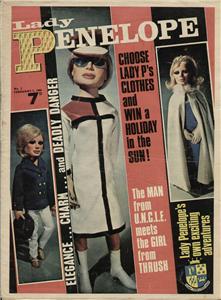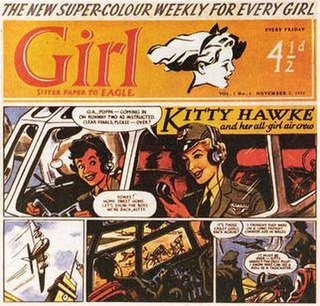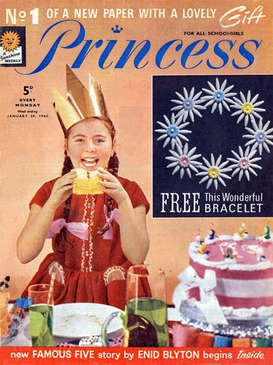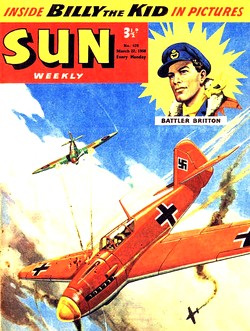
A British comic is a periodical published in the United Kingdom that contains comic strips. It is generally referred to as a comic or a comic magazine, and historically as a comic paper.

Tiger was a weekly British comics periodical published by Amalgamated Press, Fleetway Publications and IPC Magazines from 11 September 1954 to 30 March 1985. The title was initially launched in a large tabloid size to mimic newspapers; while it featured some action-adventure stories Tiger contained a large number of sport strips. The most famous of these was "Roy of the Rovers", which debuted in the first issue and was the comic's most popular feature, eventually transferring to its own comic in 1975. Tiger would go on to become one of the company's longest-running titles, notching 1573 issues before being merged with Eagle in 1985. Over the course of its run, Tiger featured columns by numerous famous sports figures, including Ian Botham, Geoff Boycott, Tony Greig, Trevor Francis, and Charlie Nicholas.
The Amalgamated Press (AP) was a British newspaper and magazine publishing company founded by journalist and entrepreneur Alfred Harmsworth (1865–1922) in 1901, gathering his many publishing ventures together under one banner. At one point the largest publishing company in the world, AP employed writers such as Arthur Mee, John Alexander Hammerton, Edwy Searles Brooks, and Charles Hamilton. Its subsidiary, the Educational Book Company, published The Harmsworth Self-Educator, The Children's Encyclopædia, and Harmsworth's Universal Encyclopaedia. The company's newspapers included the Daily Mail, the Daily Mirror, The Evening News, The Observer, and The Times. At its height, AP published over 70 magazines and operated three large printing works and paper mills in South London.
Toxic! was a British comic that was published weekly from March 28 to October 24, 1991, by Apocalypse Ltd, with a total of 31 issues.
Jack and Jill was a British children's comics magazine published by Amalgamated Press/Fleetway/IPC between 27 February 1954 and 29 June 1985, a run of approximately 1,640 issues. In 1955, Jack and Jill absorbed the fellow Amalgamated Press title Playbox.

Lion was a weekly British comics periodical published by Amalgamated Press from 23 February 1952 to 18 May 1974. A boys' adventure comic, Lion was originally designed to compete with Eagle, the popular weekly comic published by Hulton Press that had introduced Dan Dare. It debuted numerous memorable characters, including Captain Condor, Robot Archie, Paddy Payne and the Spider. Lion lasted for 1,156 issues before being merged with stablemate Valiant.

Valiant was a weekly British comics periodical published by Fleetway Publications and later IPC Magazines from 4 October 1962 to 16 October 1976. A boys' adventure comic, it debuted numerous memorable characters, including Captain Hurricane, The Steel Claw and Mytek the Mighty. Valiant lasted for 712 issues before being merged with stablemate Battle Picture Weekly.

The Comet was a weekly British comics periodical published by J.B. Allen and later Amalgamated Press and Fleetway Publications from 20 September 1946 to 17 October 1959. Initially a children's newspaper, The Comet was transformed into a boys' adventure comic in May 1949 by editor Edward Holmes when J.B. Allen were purchased by Amalgamated Press. Also known as Comet Comic, The Comet Adventure Weekly, Comet Weekly and simply Comet as various points the title continued until October 1959, reaching 580 issues before being merged with another AP boys' comic, Tiger.
TV Comic was a British comic book magazine published weekly from 9 November 1951 until 29 June 1984. Featuring stories based on television series running at the time of publication, it was the first British comic to be based around TV programmes; it spawned a host of imitators.
TV Century 21, later renamed TV21, TV21 and Tornado, TV21 and Joe 90, and TV21 again, was a weekly British children's comic published by City Magazines during the latter half of the 1960s. Originally produced in partnership with Gerry and Sylvia Anderson's Century 21 Productions, it promoted the company's many science-fiction television series. The comic was published in the style of a newspaper of the future, with the front page usually dedicated to fictional news stories set in the worlds of Fireball XL5, Stingray, Thunderbirds, Captain Scarlet and the Mysterons and other stories. The front covers were also in colour, with photographs from one or more of the Anderson series or occasionally of the stars of the back-page feature.

Lady Penelope was a British weekly comic book magazine for girls which ran from 1966 to 1969. Produced by Century 21 Publications and published by City Magazines, it was a sister publication to TV Century 21. Lady Penelope was edited by Gillian Allan, wife of comic strip writer Angus Allan.

Tammy was a weekly British comic for girls published by Fleetway in London from 1971 to 1984. Tammy was closely linked editorially with the fellow Fleetway titles Misty and Jinty. At its height, Tammy sold 250,000 copies per week, more than popular IPC Magazines titles like 2000 AD.
Robin was a British weekly children's magazine published from 1953 to 1969, originally by Hulton Press. Robin was billed as "companion to Eagle, Girl, and Swift" and aimed at younger readers and pre-readers.

Girl was the name of two weekly comics magazines for girls in the United Kingdom.
British girls' comics flourished in the United Kingdom from the 1950s through the 1970s, before beginning to decline in popularity in the 1980s and 1990s. Publishers known for their girls' comics included DC Thomson and Fleetway/IPC. Most titles appeared weekly, with the content primarily in picture-story format. The majority of the stories were serialized, with two or three pages per issue, over eight to twelve issues. They were marketed toward young teen girls.

Princess was a British weekly girls' comic anthology published by Fleetway Publications and, later, IPC Magazines. The first version was published between 30 January 1960 and 16 September 1967, and featured a mix of comic strips, text stories and a large proportion of features; it was merged with Tina to form a new title - Princess Tina - after 399 issues.

June was a British weekly girls' comic anthology published by Fleetway Publications and IPC Magazines from 18 March 1961 to 15 June 1974. Designed as a response to DC Thomson's hit Bunty, June never quite eclipsed its Scottish rival but was nevertheless a success on its own terms, reaching 631 issues before being merged into Tammy in 1974.

Sun was a weekly British comics periodical published by J. B. Allen, Amalgamated Press and Fleetway Publications between 11 November 1947 and 17 October 1959. During this time it was also known as Sun Comic, Sun Adventure Weekly, The Cowboy Sun Weekly, The Cowboy Sun, The Sun and Sun Weekly at various points, and ran for 551 issues before merging with Lion.

Thunder was a weekly British comics periodical published by Fleetway Publications from 17 October 1970 to 13 March 1971. A boys' adventure comic, the title only lasted for 22 editions before being merged with another Fleetway title, the long-established Lion.











